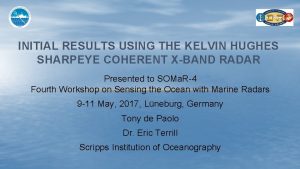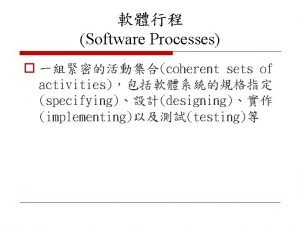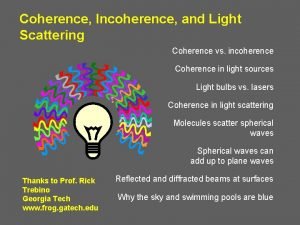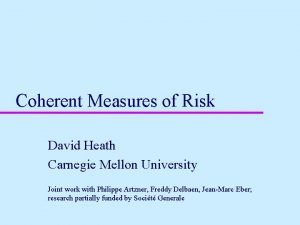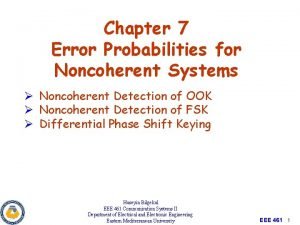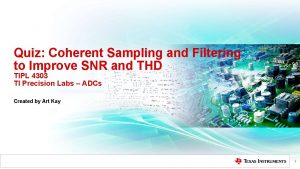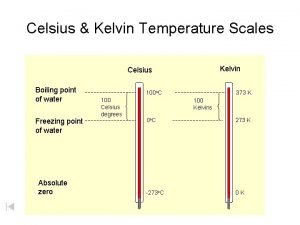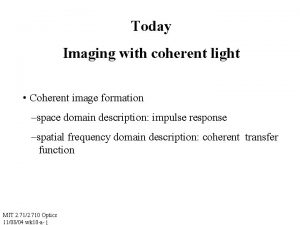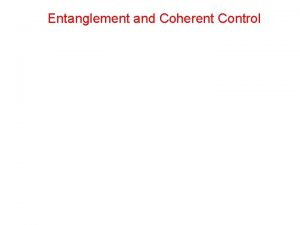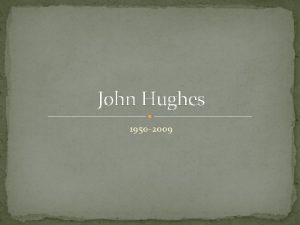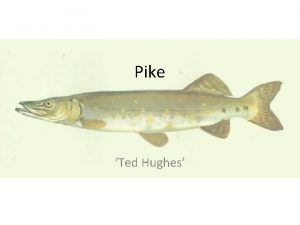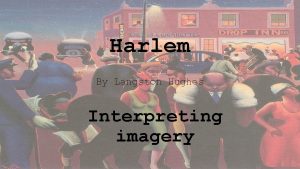INITIAL RESULTS USING THE KELVIN HUGHES SHARPEYE COHERENT


















![REFERENCES [1] Hwang, et al, “A note on Doppler processing of coherent radar backscatter REFERENCES [1] Hwang, et al, “A note on Doppler processing of coherent radar backscatter](https://slidetodoc.com/presentation_image_h/a3e103502092bec688e0a1eefb79c20e/image-19.jpg)
- Slides: 19

INITIAL RESULTS USING THE KELVIN HUGHES SHARPEYE COHERENT X-BAND RADAR Presented to SOMa. R-4 Fourth Workshop on Sensing the Ocean with Marine Radars 9 -11 May, 2017, Lüneburg, Germany Tony de Paolo Dr. Eric Terrill Scripps Institution of Oceanography

INITIAL INSTALLATION ON THE CLIFF AT SIO

SHARPEYE SPECIFICATIONS • 3 range modes with different radar pulse lengths and PRFs • 12 NM • Short pulse 25 ns – covers 4 NM • Medium pulse 5. 0 us – covers 12 NM • PRF 8000 Hz • 24 NM • Short pulse 25 ns – covers 2. 5 NM • Medium pulse 5. 0 us – covers 6. 4 NM • Long pulse 25. 0 us – covers 24 NM • PRF 5154 Hz • 48 NM • Short pulse 25 ns – covers 4 NM • Medium pulse 8. 0 us – covers 14. 8 NM • Long pulse 50. 0 us – covers 48 NM • PRF 2048 Hz • 3 rotation rates (10, 20, 40 RPM) • Transmits 2 frequencies for diversity, 16 frequency pairs available • 3 digital sample gain settings (1 x, 2 x, 4 x) • Range resolution 3. 75 m (longer pulses use pulse compression) • Angular resolution of 360/4096 degrees

SHARPEYE MAGNITUDE AND PHASE PLOTS • Sample scan from 2015 -12 -11, Hs=2. 2 m at SIO pier, Hs=3. 0 m Torrey Pines Outer Buoy, winds 20+kts • 24 NM mode, 10 RPM, frequency pair 16, 1 x digital gain setting, short and medium pulse • Backscatter out to 10 NM

SHARPEYE DOPPLER PROCESSING • Use SIO wave inversion on backscatter magnitude to determine (kx, ky, w) spectral content and current estimate • Due to 10 RPM rotation rate, the spectrum is highly aliased in frequency • Aliased spectrum is “unfolded” at two different points • Determine bulk current by Doppler shift of dispersion relationship • Determine shifted dispersion filter • Filter out measured (kx, ky, w) triplets with high SNR • Individual wave amplitudes and phases still unknown

SHARPEYE DOPPLER PROCESSING “Unfolding” of aliased spectrum Wave inversion results in 2378 (kx, ky, w) triplets, note the “twin tails” in the spectrum. Current estimate is 0. 18 m/s from 238

SHARPEYE DOPPLER PROCESSING • Due to the end fed antenna, there is a “squint” angle between the two transmitted frequencies, which is a difference in the actual azimuth measured by the two separate frequencies • For frequency pair 16 (9. 23 and 9. 35 GHz), the squint angle is 11 azimuth bins, or 0. 9668 degrees • As the antenna rotates, the higher frequency (F 2) sees returns from an azimuth 11 bins ahead of lower frequency (F 1) • Doppler samples are collected over the 0. 9668 degrees, first from F 2, then from F 1 • In the 12 NM range mode, using both frequencies and both pulses, this equates to approximately 256 Doppler samples being collected per (r, q) bin, which is fitting for FFT processing • Using only the medium pulse equates to approximately 128 Doppler samples for FFT processing • Pulse pair processing is also performed on a pair-by-pair basis

SHARPEYE DOPPLER PROCESSING The Doppler signals received from an (r, q) cell covering the squint angle of 0. 9668 degrees, in the middle of the field of view with good SNR. Top panel are the received I (blue) and Q (green) signals showing the appropriate 90 degree phase lag. These signals have been low pass filtered to reduce the noise (smooth them out). Middle panel is the first moment of the FFT of the I, Q signals, which has a peak at the Doppler frequency of 130 Hz. The green curve is a spline fit to the raw first moment in blue. Lower panel is the pulse-to-pulse phase, showing a Doppler frequency (slope) of 126 Hz. The pulse pair processing computes a Doppler frequency for each pulse pair, creates a histogram of all estimates to serve as a probability density, and then takes the first moment of the Doppler frequency estimates.

SHARPEYE DOPPLER PROCESSING Doppler velocity measured using the FFT method. There is a 1 m/s bias in the distribution with a standard deviation of 0. 9 m/s. The I, Q signals were not detrended, or high pass filtered prior to the FFT processing. This leaves in any current, or other water particle motion NOT due to orbital motion. In addition, the literature (Plant, UW/APL) indicates that using an H-pol signal increases the Doppler velocity measurements over using a V-pol signal

SHARPEYE DOPPLER PROCESSING Doppler velocity measured using the Pulse Pair method. There is a 0. 4 m/s bias in the distribution with a standard deviation of 1. 0 m/s. The close range shows the effects of the use of the short pulse have been eliminated by only using the medium pulse.

Wave Field Reconstruction from Doppler Measurements

WAVE FIELD RECONSTRUCTION FROM DOPPLER MEASUREMENTS

WAVE FIELD RECONSTRUCTION FROM DOPPLER MEASUREMENTS Using the FFT method, the resulting reconstructed wave field using the amplitudes and phases from the least squares inversion is shown on the right. The overall Hs=3. 0 m, which is a good result. The Scripps pier Hs=2. 2 m, and the Torrey Pines Outer Hs=3. 0 m.

WAVE FIELD RECONSTRUCTION FROM DOPPLER MEASUREMENTS Using the Pulse Pair method, the resulting reconstructed wave field using the amplitudes and phases from the least squares inversion is shown on the right. The overall Hs=2. 5 m, which is also good result. The Scripps pier Hs=2. 2 m, and the Torrey Pines Outer Hs=3. 0 m.

WAVE FIELD RECONSTRUCTION FROM DOPPLER MEASUREMENTS Non-coherent method Coherent FFT Method Coherent Pulse Pair Method The non-coherent method uses the subsequent 31 scans, does a 3 -D inversion, and scales the wave field uniformly. The noncoherent result is the first scan output. The coherent methods are results from that same first single scan (only). All were taken at 10 RPM, and the time bases are the same. Note the z-axes are different, either normalized to Hs=1 m, or scaled to their respective Hs result.

HIGH DOPPLER VELOCITY = BREAKING? Using the highest Doppler velocity measurements from the pulse pair method, contours of Doppler velocities above 2. 5 m/s are overlayed on the resultant wave field reconstruction. These higher Doppler velocities may be indicative of breaking. The 2. 5 m/s threshold was picked at a point two standard deviations above the mean Doppler velocity value.

OBSERVATIONS • Use of the short pulse seems to reduce the magnitude of the Doppler velocity measurements. The returned magnitudes of the short pulses are so small, they seem to add noise rather than good coherent data • The response of the system varies with which frequency is transmitted • The system needs more RF gain, but Kelvin Hughes will not do that without another development contract. We get good data in high wind and waves • The full data rate of 3 Gbits/s (375 Mbytes/s) is difficult to handle. The 28 TB data recorder would fill up in about 20 hours. We have been reducing the data rate by recording sectors instead, it seems a 90 sector, appropriately pointed into the waves will work • The non-coherent inversion to determine the (k x, ky, w) triplets needs to be narrow banded in frequency. If more triplets from adjacent frequencies are allowed in the pass band, the coherent wave inversion/reconstruction tends to grow to large in wave height as there are too many components, and therefore too amplitudes. The inversion here seems to let in the appropriate amount • The non-coherent wave inversion is more homogenous, the coherent inversion not. This may be an improvement, but will need to be proven through comparisons to other instruments

CONTINUING WORK • Integrate GPS receivers/data into the system to prepare for shipboard work • Develop more real-time software, and a non-continuous sampling scheme to reduce data and workload, e. g. sample for 10 minutes at the top of each hour • Analyze the pros/cons of the other modes of operation • Different range modes with different radar pulse lengths and PRFs • Different rotation rates • Different frequency pairs (or single frequency only) • Different digital sample gains • Compare results to other sensors, buoys, LIDAR, etc. • Deploy on R/V Sally Ride for Langmuir Cell DRI • Deploy on shore at Vandenberg AFB for Inner Shelf DRI September 2017
![REFERENCES 1 Hwang et al A note on Doppler processing of coherent radar backscatter REFERENCES [1] Hwang, et al, “A note on Doppler processing of coherent radar backscatter](https://slidetodoc.com/presentation_image_h/a3e103502092bec688e0a1eefb79c20e/image-19.jpg)
REFERENCES [1] Hwang, et al, “A note on Doppler processing of coherent radar backscatter from the water surface: With application to ocean surface wave measurements”, Journal of Geophysical Research, Vol. 115, 31 March 2010 [2] Connell, et al, “Development of an environmental and ship motion forecasting system”, Proceedings of the ASME 2105 34 th International Conference on Ocean, Offshore and Arctic Engineering (OMAE 2105), May 31 -June 5, 2015, St. John’s, Newfoundland, Canada [3] US Army Corp of Engineers, “Shore Protection Manual”, Vol. 1, 1984
 Kelvin hughes sharpeye
Kelvin hughes sharpeye Meriel hughes
Meriel hughes Importance of coherent lesson plan
Importance of coherent lesson plan Coherent accelerator processor interface
Coherent accelerator processor interface Coherent scattering
Coherent scattering Coherent ui a modern user interface
Coherent ui a modern user interface Coherent vs incoherent scattering
Coherent vs incoherent scattering Evolutionary software process models
Evolutionary software process models Resolving power equation
Resolving power equation David eber cmu
David eber cmu Coherent paragraph
Coherent paragraph Mti radar vs pulse doppler radar
Mti radar vs pulse doppler radar Probability of error for non coherent fsk
Probability of error for non coherent fsk Text coherence in nlp
Text coherence in nlp Domain 1 planning and preparation
Domain 1 planning and preparation Coherent sampling
Coherent sampling Example of cohesion in writing
Example of cohesion in writing Coherent text
Coherent text Scientific literature review
Scientific literature review Coherent line drawing
Coherent line drawing
